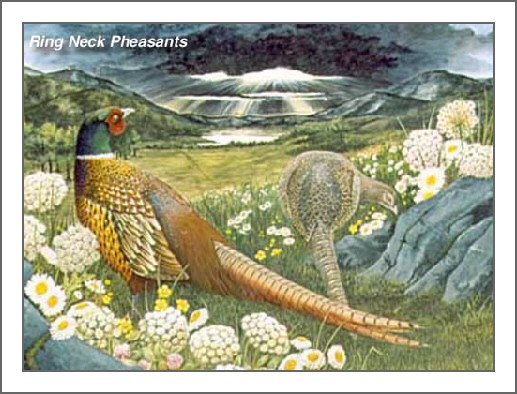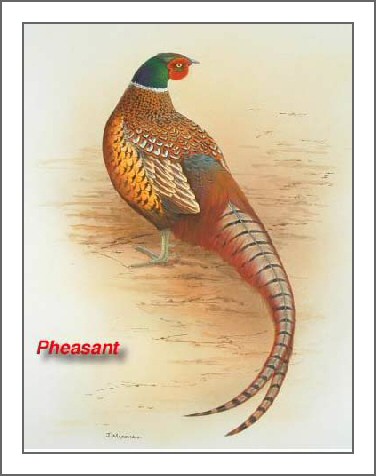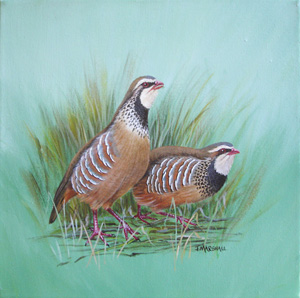

|
|
|---|
ON THIS PAGE SCROLL DOWN TO FIND THE FOLLOWING
BIRDS FOUND IN PASTURE LAND:
 from
K is for KIWI, Reed)
from
K is for KIWI, Reed)
I have a round window, it looks out on a hill, where a covey of quail come each day. The male is quite quaint, as he perches on high, calling his queen, while his plume shades his eyes. He stretches his neck to the tip of his beak, while the rest of the covey are eager to feed. Then, his call breaks the silence - I reach for my quill, to write a small poem of a quail on a hill.
![]()
PHEASANT - CALIFORNIAN QUAIL - CHUKOR PARTRIDGE &
BROWN QUAIL - GREY PARTRIDGE - RED LEGGED PARTRIDGE - SPUR-WINGED PLOVER -
PIPIT AND SKYLARK -CATTLE AND LITTLE EGRETS
![]()
PHEASANT
|
|
|
Pheasant Phasianus colchicus FAMILY: Phasianidae Introduced from mixed origins since 1842. Protected but may be hunted in the open season.There is a patchy wild distribution, mainly in the North Island, in hedgerows and scrubland. They feed on berries, insects and seeds. Breeding is from September to January and the nest is a scantily lined hollow in thick cover. The eggs, 6-14, are a uniform olive-brown. Only the female incubates and cares for the young, and one cock will often breed with more than one female. Wild stock are being supplemented by annual liberations.
![]()
CALIFORNIAN QUAIL
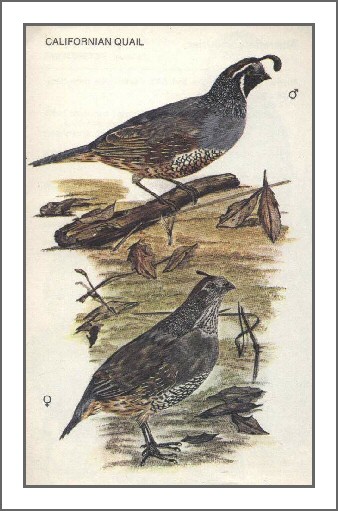
Californian Quail Lophortyx califoricus FAMILY: Phasianidae Introduced from the USA in 1862. Protected, but they may be hunted in the open season in some locations. Found throughout NZ, plentiful in some areas such as Taupo, Marlborough, Central Otago. They frequent farmland with hedges and scrub, and occasionally parks and gardens. Outside the breeding season they form 'coveys' or family groups, They feed mainly on seeds and soft grasses. Breeding is from October to December, the nest being a simple ground hollow near or under cover. The eggs, 9-16, are creamy-yellow blotched all over with dark brown. Only the female incubates.
Bobwhite quail have also been introduced into NZ. Pictures and information on these birds will be added soon.
![]()
CHUKOR PARTRIDGE & BROWN QUAIL
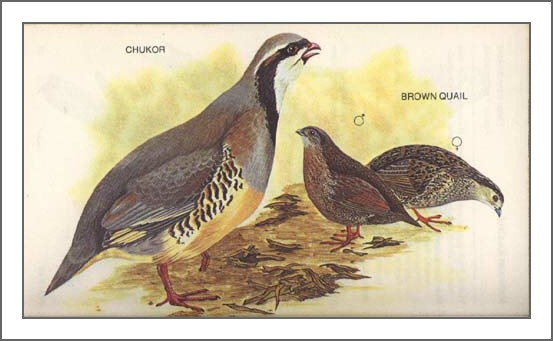
Chukor Alectoris chukar FAMILY: Phasianidae Introduced from Persia and Pakistan in the 1920s. Liberations from hand reared stock continue. Protected - but may be hunted in the open season. Half the size of a Pheasant with white cheeks and throat bordered by a black band. These birds are seen in coveys or family groups of up to 10 or more in Autumn. In flight there is a loud whirring of the wings. They are patchily distributed from Marlborough to northern Southland, liberated in the middle of the 1900s in Hawke's Bay. Found in high country from 700-1500mt with a prefence for sunny, dry rocky faces. They are seldom far from running water and feed on seeds, grassy roots and some insects. Breeding is from September to January and the nest is a hollow in the ground among rocks, bush or tussock shelter. The eggs, 10-16, are greyish, freckled with brown spots. Only the female incubates.
Brown Quail Synoicus ypsilophorus FAMILY: Phasianidae Introduced from Australia in the 1860s - 1870s. Protected but may be hunted in the open season. Smaller than the Californian Quail, all brown in colour with no crest. They run rat-like through the grass and are difficult to flush. They form small coveys outside the breeding season. They are widespread in the lowlands of the North Island but is scarce in the southern half. Found on the edges of swamps and scrub and sometimes in open ground, they feed on seeds, clover leaves, insects and snails. Breeding is from October to January and the nest is a depression lined with grass and leaves, under cover. The eggs, 7-11, are dull white, finely spotted all over with light brown. Only the female incubates.
![]()
|
|
RED LEGGED PARTRIDGE - Alectoris rufa rufa Introduced. Family: Phasianidae; Species: rufa; Order: Galliformes Other common names: — French partridge
31 cm; like chukor in size and plumage. Red legs, red bill, throat white with black necklace higher on throat and streaked black and white on lower throat. Sexes alike. Habitat: Their preferred habitat is rolling hill country with scrubby gullies, dry lowlands and farmland. They prefer habitat which supplies dense cover. Breeding: Nests in hedgerows, plantations, fields of crops and wasteland. The nest is a hollow scrape in the ground, scantily lined with dead leaves, grass etc. Eggs: 8 - 20, yellowish white to yellowish brown sparingly spotted with ochreous-red and ashy shell markings. Food includes grasses, seeds, clover, buttercups, insects and spiders. Where to find: — Birds were released in the Upper Moutere Valley near Nelson, Marlborough, Canterbury, and between Kaipara Harbour and Taumarunui, Bay of Plenty, Gisborne and Hawkes Bay. In New Zealand, introductions in the late 19th century met with little success, but attempts in the 1980s has met with mixed success. The species is now common on many game bird preserves.

GREY PARTRIDGE
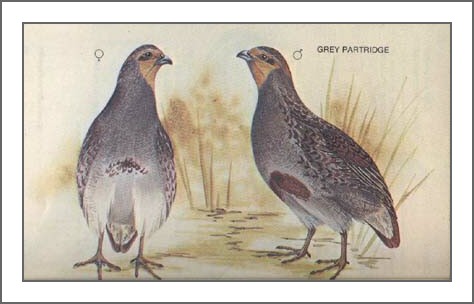
Grey Partridge Perdix perdix FAMILY: Phasianidae Introduced from Denmark as eggs in 1962 and liberted from hand-reared stock. Fully protected. These birds are larger than the Californian Quail with a general grey colour all over. The male has the more prominent breast patch. Immature birds lack the rusty face and chest markings. They do not normally perch, and will rise with whirring wings for short flights. The voice is a loud hoarse "kurr-ic, kurr-ic". They form small coveys outside the breeding season. Over 40,000 birds were liberated but they are still rare in the wild. Reports from North Canterbury, Southland, Bay of Plenty, Taranaki and Hawke's Bay. They are found in open country near hedgerows, shrubs and crops. They feed on seeds, insects and plant matter. Breeding is from October to January and the nest is a depression in grass, near grass or among heavy grass or hay paddocks. The eggs, 9-18, are uniform olive-buff. Only the female incubates.
![]()
SPUR-WINGED PLOVER
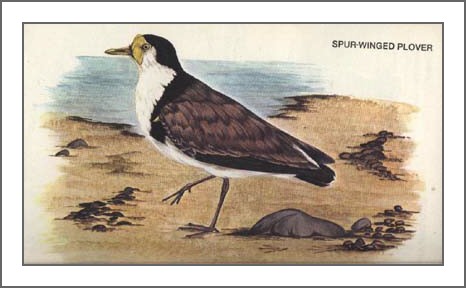
Spur-winged Plover Lobibyx novaehollandiae FAMILY: Charadriidae Native, straggling from Australia since 1886 and breeding in NZ since the 1940s. Fully protected. Size of a pigeon with slow flapping wing beat, often calling while in flight at dusk. Has distinctive yellow face wattles. Common in the South Island, spreading north to the North Island. Inhabits pasture and low crops, often near water courses, swamps and the seashore. They form flocks in Autumn and feed on insects and worms. Breeding is from July to December and the nest is a scrape in the ground with virtually no nest material. The eggs, 3-4, are muddy-green with varying blotches of purplish-brown all over.
![]()
NZ PIPIT / Pihoihoi & SKYLARK
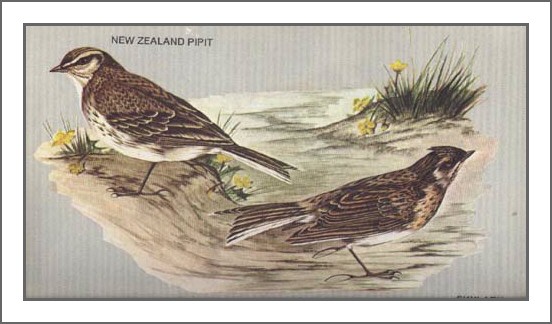
New Zealand Pipit Anthus novaeseelandiae FAMILY: Motacallidae Native, with very similar species all over the world. Fully protected. Similar to the Skylark but lacking the crest and greyer in colour. Pipit often flick their tail and have a prominent eye stripe. Their call is 'pi-pit', commonly from a low perch. Found throughout NZ in open or scrub country up to alpine. They can often be seen on beaches and roadsides. They feed mainly on worms and insects. Breeding is from August to March and there is more than one brood per season. The nest, which is on the ground, is a large deep cup lined with dry grass and well concealed under vegetation. The eggs, 3-4, are cream, heavily blotched with brown and grey which often conceals the cream.
![]()
Skylark Alaua arvensis FAMILY: Alaudidae Introduced from Europe from 1864 onwards. Not protected. This bird has a marked crest which is raised when startled. The song is a long trill, often sung while in flight as the bird gets higher and higher in the sky. The Skylark has a noticeably longer and straighter hind claw than the Pipit. Found throughout NZ in all types of open country up to a high altitude, but not alpine. They feed on seeds and insects. Breeding is from October to January with more than one brood. The nest is a neat grass lined cup well concealed in tall grasses and rushes. The eggs, 3-7, are yellowish-cream, thickly blotched all over with brown and grey, which often forms a circle at the larger end.
![]()
CATTLE AND LITTLE EGRETS
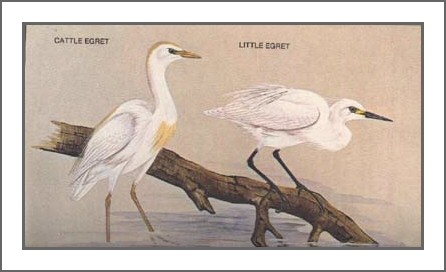
Cattle Egret Bubulcus ibis FAMILY: Ardeidae Native, first reported in Otago in 1963 and first possible breeding in NZ in 1974. It has an expanding distribution throughout the world in temperate and tropical zones. Fully protected. Very small, being half the size of the White Heron. Winter plumage is white, with a stout yellow bill and green-yellow legs. The Summer [breeding] plumage has a pale buff crown, nape, chest and back plumes. The immature bird is like the Winter plumage. Cattle Egret are rare visitors throughout the year, probably from Australia. They can be found in open paddocks with cattle, sheep and horses, and feed mainly on the insects that are disturbed by the stock. Breeding in Australia is from October to December. The nest is a platform of twigs and sticks, in trees, and in colonies in conjunction with other herons. The eggs, 3-6, are bluish-white.
![]()
Little Egret Egretta garzetta FAMILY: Ardeidae A visitor probably coming from Australia. Various sub-species in Europe, Sth Asia, parts of Africa, the Philippines, New Guinea and N. & S. Australia. Fully protected. Same size as the Cattle Egret, this bird is pure white with a slender black bill, black legs with the soles of the feet light green. During breeding season they have plumes on the back and two on the head. Little Egret are rare visitors throughout the year, and can be seen at coastal lagoons and muddy estuaries throughout NZ. They feed on fish, molluscs, crustacea and amphibia. They breed in Australia, according to the rainy season. The nest is of sticks, in high trees and in colonies. The eggs, 4-5, are greenish-blue with a white, chalky surface.

Copyright(c) 2006 Janet Marshall. All rights reserved.
myid@myhost.com
nbsp;
nbsp;














